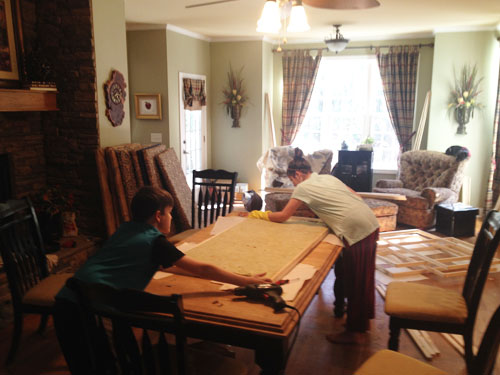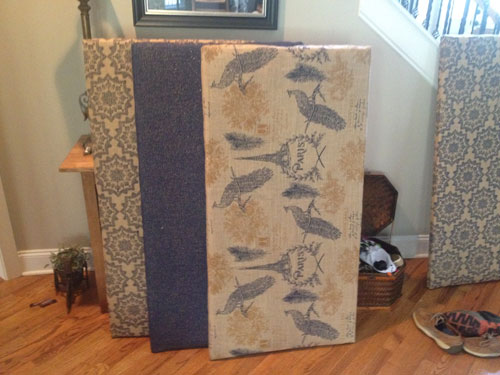Thoughts
Building acoustic panels
I know that many of you don’t really care about what I am going to write in this post but some of you will and maybe it will help you in some way. At any rate, I warned you that I was going to write about some studio stuff since I am knee deep in it and having to learn a lot.
Within a few weeks, I expect my studio to be ready to record in. All the electronic equipment is purchased and sitting here ready to go. The studio has been soundproofed (within reason) and just needs carpet to basically be ready. I could be in there within days but it is part of a larger project (my entire basement) which will include another bedroom, a bathroom and a large living area.
When you build a studio, there are two major sound considerations. Soundproofing is one of them. Soundproofing is the process of trying to keep sound from leaving the room and entering the room. The technology we used to do that included rock wool insulation, some mass loaded vinyl, and doubled dry wall. However, the big and more expensive things we had to do involved decoupling the wall and green glue.
Decoupling basically is a process where the inside drywall is disconnected from the studs by a series of clips. It makes the drywall semi-float inside the studs and that prevents vibrations from passing between the studs and drywall. The studs are part of the rest of the house and the drywall is part of the studio and in theory, they are decoupled. Green glue is a newer technology. You spread the glue between doubled sheets of drywall and it absorbs vibrations that are trying to pass in or out of the room.
The other major sound consideration besides soundproofing is actually treating the sound that is inside the studio itself. If sound can’t get out of a room, it sort of bounces around until it is absorbed by something. Sometimes, that is an interesting sound but normally it is a bad thing because sound bouncing around creates echoes and other problems. In a recording situation, you end up with sound that lacks clarity. and you often start hearing a very mushy bass. I hate that sound. When I play a piano and hear sound bouncing all around me, it makes me feel out of control. I like for sound to be absorbed almost instantly so that the notes I am playing are not competing with the notes I played just before those notes.
The way we control that problem both in a studio but also in any performing venue is by putting soft things in the room that will absorb sound. For example, some performance halls have heavy curtains that are used in different ways to get different kinds of sounds. In a studio, you often see foam on the walls or acoustic panels. Or, you will see walls built out of soft surfaces similar to cubicles in an office.
The acoustic treatment quotes I got for my studio were somewhere over $2000 for foam and bass traps (special panels for absorbing low frequency sounds). There are various formulas and calculations that tell you want you need. But after a lot of research online, I decided to pass on all of them and build my own acoustic treatments. We made 16 panels for the walls (two feet by four feet) and 4 bass traps (two feet by six feet). It cost me about $500 + the cost of a treat night for my children who if I am being honest ended up doing most of the work.
Here is what we used:
1) Inexpensive 1×2 and 1×4 pine boards to make frames.
2) Rockwool insulation that is board-like and sometimes called rockboard. It takes some work to find a local building supplier that carries this kind of product and the popular brands are Roxul and Delta. It costs about $0.70/sq ft. You can buy it online but it costs more plus the shipping cost is outrageous. I bought 2×4 ft sheets (2 inches thick) in 4 lb. and 8 lb. densities. (The higher the density, the more effective on low frequencies so the 8 lb. insulation was used in the bass traps.)
3) Burlap. After putting the insulation in the frame, you have to stretch cloth over it and staple it. I chose some decorative burlaps from Joann Fabrics. With their 50% off coupons, it costs about $5/yard.
The acoustic panels for the walls are just single sheets of 4 lb insulation but in the bass traps, we used two layers of 8 lb insulation. Here is a pic of the kids building them.
And here is a picture of how they look done.
You can do this kind of thing for any room that you feel is too live. Many churches use panels like this. Even in your house, you might have a problem with a too-live room, especially if you have your piano on a hard floor rather than carpet. This is an inexpensive way to fix that.


